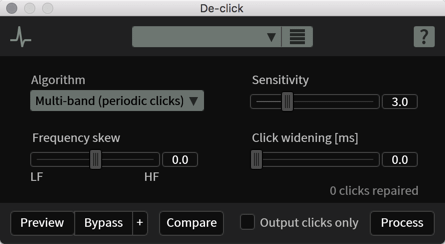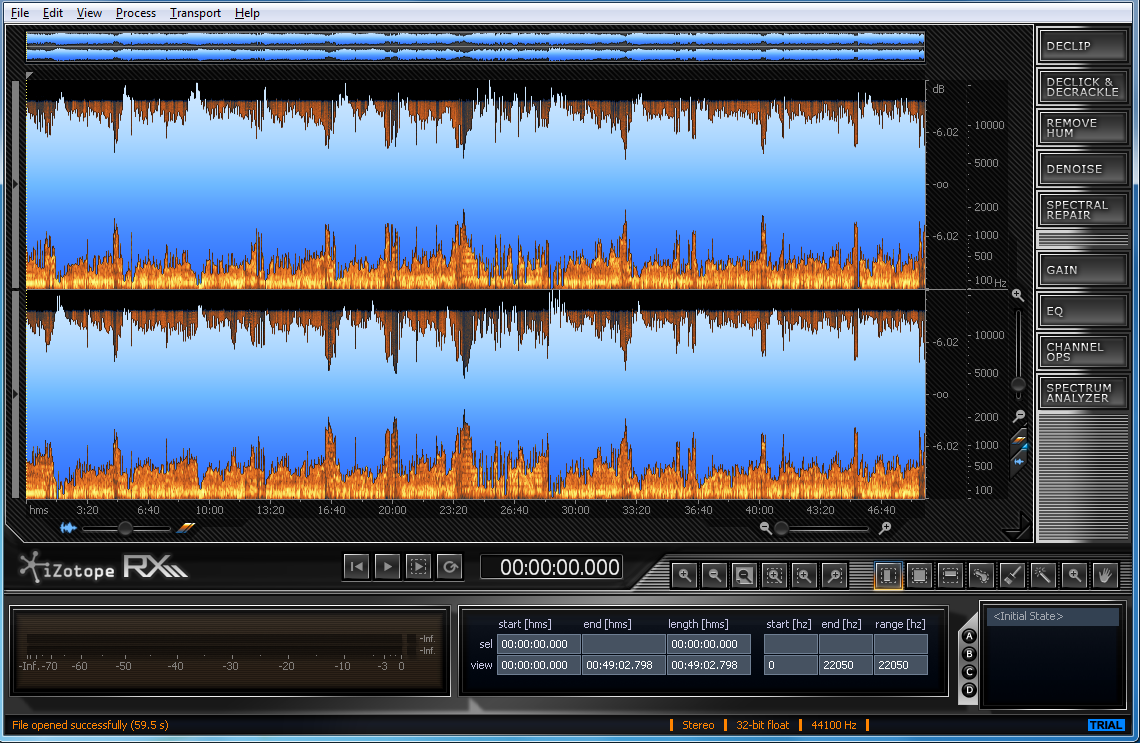When to use Declicker
Declicker is useful for restoring for old vinyl and other phonograph recordings that are riddled with clicks, pops and crackles. Declicker can also remove a variety of short impulse noises from other sources, including some clicks caused by digital errors.
Automatic or Manual Declicking?
Declicker features both Manual and Automatic modes. Automatic mode can look at a whole file, or a selection, and detect and remove clicks and pops. For audio files that have clicks and pops throughout the file, Automatic declicking is the best choice as it will save you a lot of time. The Manual declick mode is useful when you want more precise control over repairing clicks, or in some cases where there are a few hard to fix clicks left over after running the Automatic declick mode. Manual declicking must be performed on each event individually.
Using Automatic Mode
Izotope Rx 3 Declicker Vs Rx 6 Mouth Declick Telecharger Teamviewer 9 Mac Best Bpm Analyzer 2015 Virtual Dj Music Effects Free Download Izotope Rx Plug In For Fcpx Garageband Ipad Guitar Pedals Remove Bird Cheeps In Izotope Rx 7 How To Uninstall Garageband From Mac Rane Ttm 56. For the first 10 days after installation, RX will run in Trial mode, which offers full functionality with the exception of saving and batch processing. After 10 days, RX will revert to Demo mode. In Demo mode, RX is limited to 30 seconds of continuous playback. And now, with their latest and greatest version – “RX 3 Advanced” – iZotope has added two brand new plugins into the RX fold: Dialogue Denoiser and Deverb. Let’s jump in, and see what RX 3 Advanced is all about! TECH SPECS: RX 3 Advanced is a Native-only plugin for MAC and PC and retails for $1,199. Formats are AAX, RTAS, AudioSuite.
Izotope Rx Declip
When using the Automatic mode, start by setting the Maximum Click Width control, then adjust the sensitivity control to fine tune click attenuation. Before running declicker in automatic mode, it is a good idea to look at the Spectrogram display and visually identify clicks to inspect how wide they are, as this will help you see roughly what your Maximum Click Width and sensitivity should be set to.
Hit preview to hear the result of your settings, and as audio is playing back, fine tune the sensitivity and click width sliders to remove the most clicks and pops. The ideal setting should remove the most clicks without damaging transients in the program material. For example, drum hits may be mistaken for clicks at high Width and Sensitivity settings.
To better hear what is being removed, toggle the Output Clicks Only control during preview playback. This will let you hear what is being removed from the audio, allowing you to fine tune your settings.
Note: for material with clicks and pops of very different sizes, try running Declicker in several passes. Start with repairing short clicks, and then continue to longer ones.
Using Manual Mode
To locate clicks, display both waveform and spectrogram by dragging the waveform/spectrogram transparency slider to the center. Clicks will be visible as vertical lines on the spectrogram. To select a click precisely, zoom in and inspect the waveform. While spectrogram will help with finding clicks, the waveform display will help you accurately select click boundaries.
Select the click and press Apply. The click will be removed using interpolation from the surrounding audio data. If the result is not satisfactory, try adjusting Interpolation Order or other parameters. If the click or pop is very long, Declicker may cause a short level drop. In this case, consider using the Spectral Repair tool instead of Declicker.Read more about Declicker controls in the Reference Guide.
Imagine you have a sound file that was badly recorded, with no possibility to re-record, and with no clean version : how to deal with the clipping, the saturation, the distorsion ?
Imagine you have a mix/(pre)mastering that was crushed-to-death in a “loudness war” fashion and you have lost all the original files :
how to fix this mess ?
Is there a possibility to clean / smooth the sound ?
how to “unsaturate” ?
Izotope Rx 3 Declicker Vs Rx 6 Mouth Declick 2
can i have declipping ?
-> no <-

it’s too late, we can’t go back to the clean sound!
But we can do our best to limit the damages.
here’s some informations : http://www.wavosaur.com/forum/can-distortion-be-removed-or-minimized-t1262.html
Izotope Rx Decrackle

And now a selection of plugins to help fixing the clipping disasters :
I won the loudness war
Declipper plugins :
Some editors provide plugins that can add some improvements, Izotope has developed a suite, intended for repairing audio : this include music restoration, “declipping”, noise removal etc.. It’s a bit expensive but if you really need it, you have it all !
Izotope RX3

more info and download demo @ http://www.izotope.com/products/audio/rx/
We have hunted down freeware declipper plugins on the interweb, we only found two, three if we include the “transient designer” (it can heal some overcompressed files) :
Relife 1.42

More info and free download @ http://www.terrywest.nl/utils.html
This free VST declipper can bring the oversqueezed samples to life, or smoothes a bad vocal recording. It was used on the clipped sample you can see on the first picture.
Don’t expect miracles, but don’t hesitate to test the three algo, to find which is working best for you.
Declipper DX plugin 2.5
Declipper plugin 2.5
Free download @ http://www.silksound.com/geniesys/
This is a directX plugin, you have to use a DX-VST wrapper (like vb ffx4) in order to make it work in Wavosaur.
This free declipping plugin try to resynthetize the peak lost by the overclipping, It has advanced controls, you can have a look at the help to understand how it works. It aslo has a compress feature.

Bittersweet 3
Informations & Freeware download @ http://www.fluxhome.com/products/freewares/bittersweet-v3
This one is not intented for “declipping” but is a transient designer, and it can help to get a smoother sound. It’s subtle, and more important : it has a big knob !
Don’t expect wonders, once a signal is clipped / saturated / overclipped / distorded, you can’t go back to a clean signal.